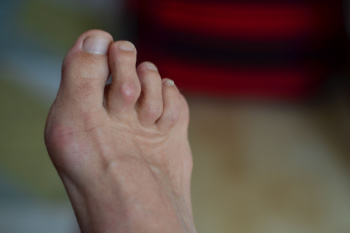
Hammertoe surgery is a procedure to correct a deformity in the second, third, or fourth toe when the middle joint bends and the toe looks like a hammer. This outpatient procedure is designed to lessen pain and improve flexibility when the toe muscles cannot stretch and straighten on their own. A podiatrist may recommend hammertoe surgery after conservative options have failed. Options include fusion, tendon transfer, or joint resection to straighten the toe. Fusion cuts the bone ends and uses pins, rods, or screws to keep the toe straight. Tendon transfer reroutes a tendon to help the toe lie flat. Joint resection removes part of the bone and uses pins to hold alignment. Recovery from hammertoe surgery involves wearing a surgical shoe or boot, keeping weight off the foot, and follow-up visits for pin or stitch removal. If you have a painful hammertoe, it is suggested that you schedule an appointment with a podiatrist for an exam and appropriate treatment options.
Foot surgery is sometimes necessary to treat a foot ailment. To learn more, contact one of our podiatrists of Columbus Podiatry & Surgery. Our podiatrists will assist you with all of your foot and ankle needs.
When Is Surgery Necessary?
Foot and ankle surgery is generally reserved for cases in which less invasive, conservative procedures have failed to alleviate the problem. Some of the cases in which surgery may be necessary include:
- Removing foot deformities like bunions and bone spurs
- Severe arthritis that has caused bone issues
- Cosmetic reconstruction
What Types of Surgery Are There?
The type of surgery you receive will depend on the nature of the problem you have. Some of the possible surgeries include:
- Bunionectomy for painful bunions
- Surgical fusion for realignment of bones
- Neuropathy decompression surgery to treat nerve damage
Benefits of Surgery
Although surgery is usually a last resort, it can provide more complete pain relief compared to non-surgical methods and may allow you to finally resume full activity.
Surgical techniques have also become increasingly sophisticated. Techniques like endoscopic surgery allow for smaller incisions and faster recovery times.
If you have any questions please feel free to contact our office located in Columbus, OH . We offer the newest diagnostic and treatment technologies for all your foot and ankle needs.

Swimming is an excellent low-impact exercise that can help improve a variety of foot conditions by reducing pressure on joints while promoting movement and circulation. Conditions such as Achilles tendonitis, bunions, metatarsalgia, and plantar fasciitis can benefit from swimming due to the gentle resistance and support water provides. The buoyancy helps relieve stress on the feet while strengthening surrounding muscles and improving flexibility. Swimming also enhances blood flow, which aids in reducing inflammation and supporting healing. A podiatrist can help determine if swimming is suitable for your specific condition and recommend complementary treatments or exercises. If you are managing chronic foot pain or recovering from injury, it is suggested that you consult a podiatrist to learn how swimming can become a valuable part of your treatment and rehabilitation plan.
Foot Pain
Foot pain can be extremely painful and debilitating. If you have a foot pain, consult with one of our podiatrists from Columbus Podiatry & Surgery. Our podiatrists will assess your condition and provide you with quality foot and ankle treatment.
Causes
Foot pain is a very broad condition that could be caused by one or more ailments. The most common include:
- Bunions
- Hammertoes
- Plantar Fasciitis
- Bone Spurs
- Corns
- Tarsal Tunnel Syndrome
- Ingrown Toenails
- Arthritis (such as Gout, Rheumatoid, and Osteoarthritis)
- Flat Feet
- Injury (from stress fractures, broken toe, foot, ankle, Achilles tendon ruptures, and sprains)
- And more
Diagnosis
To figure out the cause of foot pain, podiatrists utilize several different methods. This can range from simple visual inspections and sensation tests to X-rays and MRI scans. Prior medical history, family medical history, and any recent physical traumatic events will all be taken into consideration for a proper diagnosis.
Treatment
Treatment depends upon the cause of the foot pain. Whether it is resting, staying off the foot, or having surgery; podiatrists have a number of treatment options available for foot pain.
If you have any questions, please feel free to contact our office located in Columbus, OH . We offer the newest diagnostic and treatment technologies for all your foot care needs.

Plantar fasciitis involves inflammation of the thick band of tissue running along the bottom of the foot. It often results from repetitive stress or strain on the plantar fascia. Causes include standing for long periods of time, wearing shoes with inadequate support, or engaging in high-impact activities. Risk factors include obesity, flat feet, high arches, and tight calf muscles. Symptoms typically involve sharp heel pain, especially with the first steps in the morning. A podiatrist can help by providing a thorough exam, prescribing custom orthotics and stretching exercises, and offering guidance on proper footwear. If heel pain is affecting your daily life, it is suggested that you promptly schedule a visit with a podiatrist to start your path to relief.
Plantar fasciitis is a common foot condition that is often caused by a strain injury. If you are experiencing heel pain or symptoms of plantar fasciitis, contact one of our podiatrists from Columbus Podiatry & Surgery. Our podiatrists can provide the care you need to keep you pain-free and on your feet.
What Is Plantar Fasciitis?
Plantar fasciitis is one of the most common causes of heel pain. The plantar fascia is a ligament that connects your heel to the front of your foot. When this ligament becomes inflamed, plantar fasciitis is the result. If you have plantar fasciitis you will have a stabbing pain that usually occurs with your first steps in the morning. As the day progresses and you walk around more, this pain will start to disappear, but it will return after long periods of standing or sitting.
What Causes Plantar Fasciitis?
- Excessive running
- Having high arches in your feet
- Other foot issues such as flat feet
- Pregnancy (due to the sudden weight gain)
- Being on your feet very often
There are some risk factors that may make you more likely to develop plantar fasciitis compared to others. The condition most commonly affects adults between the ages of 40 and 60. It also tends to affect people who are obese because the extra pounds result in extra stress being placed on the plantar fascia.
Prevention
- Take good care of your feet – Wear shoes that have good arch support and heel cushioning.
- Maintain a healthy weight
- If you are a runner, alternate running with other sports that won’t cause heel pain
There are a variety of treatment options available for plantar fasciitis along with the pain that accompanies it. Additionally, physical therapy is a very important component in the treatment process. It is important that you meet with your podiatrist to determine which treatment option is best for you.
If you have any questions, please feel free to contact our office located in Columbus, OH . We offer the newest diagnostic and treatment technologies for all your foot care needs.

